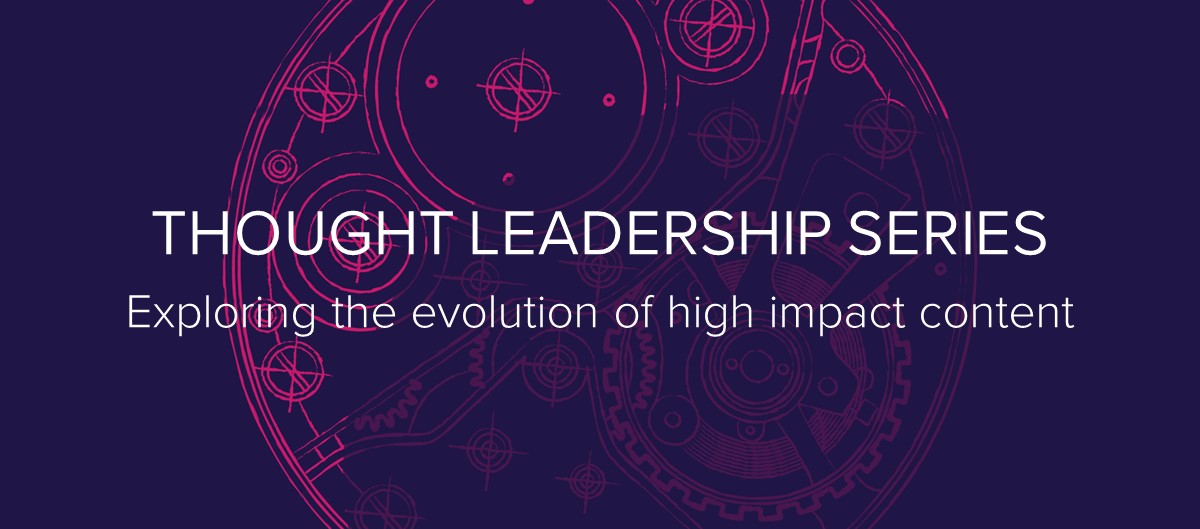The five A’s essential to thought leadership campaigns
May 19, 2020 • 4 minute read

As we continue our series exploring the critical factors for successful thought leadership campaigns, we consider how professional services firms can ensure they get the most value from their content at a time when digital outreach is more valuable than ever before.
When it comes to implementing an effective thought leadership programme, much of the important groundwork should be done before an organisation hits the green light and activates the content. Creating maximum impact is even more vital when times are tough with careful planning, internal engagement, flexibility and commitment essential. Here we look at five key factors to ensure thought leadership really hits the mark:
Alignment
It sounds obvious, but thought leadership programmes must be in step with clear business objectives – otherwise the firm in question is simply creating the content for the sake of it. There can be many reasons for misalignment: from confusion around what the strategic objectives are, to different parts of the business operating in different nuanced markets and territories, to an individual stakeholder or team’s desire to have a voice on a topical issue that sits outside the firm’s core area of focus. This can lead to a disjointed narrative and can create internal conflict regarding messaging.
Analytics
Clearly define what should be measured and when. Identifying key milestones at the outset helps shape strategy and ensures focus is not lost along the way. Proper use of data will help businesses understand what aspects are resonating most with their target audiences and therefore what aspects of previous campaigns to dial up and dial down in the future.
Thought leadership is about identifying the overlap between the issues that matter most to your target audiences and your firm’s sector expertise. Analytics and social listening tools can be a very effective means of mapping audience trends and identifying where the firm’s biggest opportunities lie before considering how to engage in a way that powerfully demonstrates brand value.
At its heart, this is about converting data into opportunity, whether that translates into increased brand awareness, direct sales or deeper business relationships. Additionally, proper use of data will allow for targets to be set which will help demonstrate value to the board when hitting KPIs, ensuring budgets are retained or even increased.
Advocacy
Once the content and approach have been agreed, you need internal buy-in from key stakeholders in the business. There must be clarity around what the message is and what the objectives of the campaign are to ensure that people want to get involved and do so in a way that articulates it powerfully rather than undermines it. That requires explaining to everyone what the business is doing in terms of thought leadership, why they are doing it, what form it will take and what part they can play in communicating it, as well as being prepared for feedback.
A good example of where internal advocacy falls down is in social media activation. If key figures are unsure about how best to share the firm’s content on their personal platforms then your campaign risks losing out on its most important cheerleaders. Despite the fact that on average only 3% of employees share content, they generate 30% of all social media engagement for a typical business. If your stakeholders have an average of 300 connections each and you persuade just 10 of them to share an update, that’s 3,000 more people who can see your content.
Stakeholders are more likely to share content if their marketing teams establish clear reasons why they should. It’s difficult to turn employees into advocates without a clear idea of what’s in it for them.
Amplification
During his recent guest appearance on the Infinite Global Podcast, Lewis Woodward, a former EY Partner and leader of its communications and engagement function, estimated that an organisation’s people drive around 70% of its brand awareness, while marketing/comms activities account for around 30%. With that in mind, businesses need all their staff on board, sharing content and engaging in the conversation both at launch and beyond. A multi-channel approach where content is delivered over a range of different platforms is another critical means of magnifying its impact.
You are unlikely to activate your thought leadership campaign on social media at any significant scale by relying on organic posts only. With the costs of creating a variety of dynamic content forms falling due to advances in technology, getting the right investment in paid advertising is essential if you’re going to achieve significant visibility and reach.
Agility
Alignment with business objectives does not mean a campaign has to be set in stone. Yes, it must be built on a firm foundation, but that does not preclude being open-minded and flexible, adapting activity over time to ensure that content is topical. That could mean refining messages as issues evolve or the news agenda changes, but it could also mean re-thinking how content is formulated and presented based on how it is received in the marketplace.
A reactive engine is essential in responding to opportunities to engage and inform your audiences to keep your business at the heart of the debate. Many firms use email alerts, blogs and explanation videos as an effective means of responding to situations that affect their followers. The key is to make sure that your firm is able to create and, most importantly, sign off content that adds value as quickly as possible.
Need help creating unique, targeted engaging thought leadership? Infinite Global can help you develop a bespoke strategy to suit the needs of your firm, empower your stakeholders and connect with your audience.